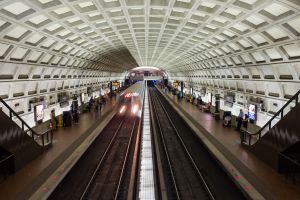
Source: Filippo Manaresi / Getty
After Carol Glover died on a smoke-filled train, a track problem was ignored that led to a derailment, repeated red signal violations and other safety issues. Now, Metro’s new chief safety officer Patrick Lavin is facing a big task that he believes begins with understanding what Metro’s problems really are.
Lavin has more than 30 years of experience, beginning as a signal maintainer and working his way up to lead investigator in New York City. He promises to provide Metro with the resources needed to help turn around the agency’s long languishing safety culture.
“I understand maintenance testing and practices from the standpoint of somebody who has dirt under their fingernails doing it,” Lavin said.
“You cannot oversimplify the condition by going ‘we had an arcing insulator,’ because an arcing insulator can result from a lot of things: you could have it from water intrusion, you could have it from a poor maintenance program, you can have it from a piece of equipment that has outlived its useful lifespan, so you don’t want to fall into the trap of thinking that there’s a single solution for the same problem. You have to diagnose what the problem is at each location and come up with a holistic plan on how to address it overall,” he said Thursday.
“It doesn’t give you any value to have a blame game. What you need to do is identify the resources you need, commit to getting those resources, implement effective programs, and that’s how you turn the tide,” he said of overall fixes to the system.
“So you can imagine what it would take to turn a system like that around, which we did through capital investment, which we did through intelligent leadership, which we did through developing effective maintenance and permanent maintenance programs. I have that experience, and I’d like to translate it to the WMATA environment,” he said.
Lavin started his career in New York after getting electrician training at a vocational high school. He said it was a natural place to find a job, since he had both friends and family working on the city’s transit system.
Now, with some family members in Virginia, Lavin sees the move to the D.C. area as “a great opportunity to improve the safety culture,” and his career.
There has been significant tension between the Federal Transit Administration and Metro over a series of safety directives and the order of major 24/7 track work that is expected to begin next month.
“I think it’s a great thing to have friction among the agencies; it makes both agencies perform better. I welcome independent scrutiny because it holds our feet to the fire, and I think it’s a great thing,” Lavin said.
He cautions against backlash against Metro workers.
“The perception at a lot of organizations is that you should get rid of your employees because ‘look at the state of the system,’ and that is a genuine opinion …. however, you need to get beyond that because if you’re not giving your employees the chance to have track access to get on the track and make those repairs, then is it really that employee’s fault? Is that the person you should get rid of, or should you fix the track access issues, get on the track, make repairs, and move to a better place?” he said.
In order to really figure out what it will take to bring Metro up to a point where only regular maintenance is needed, Lavin will survey the conditions of equipment across the entire system to sort out how long the equipment will last.
Despite U.S. Transportation Secretary Anthony Foxx’s statement that he was considering a safety shutdown of the Metro system, Lavin says that “riders can feel comfortable.”














